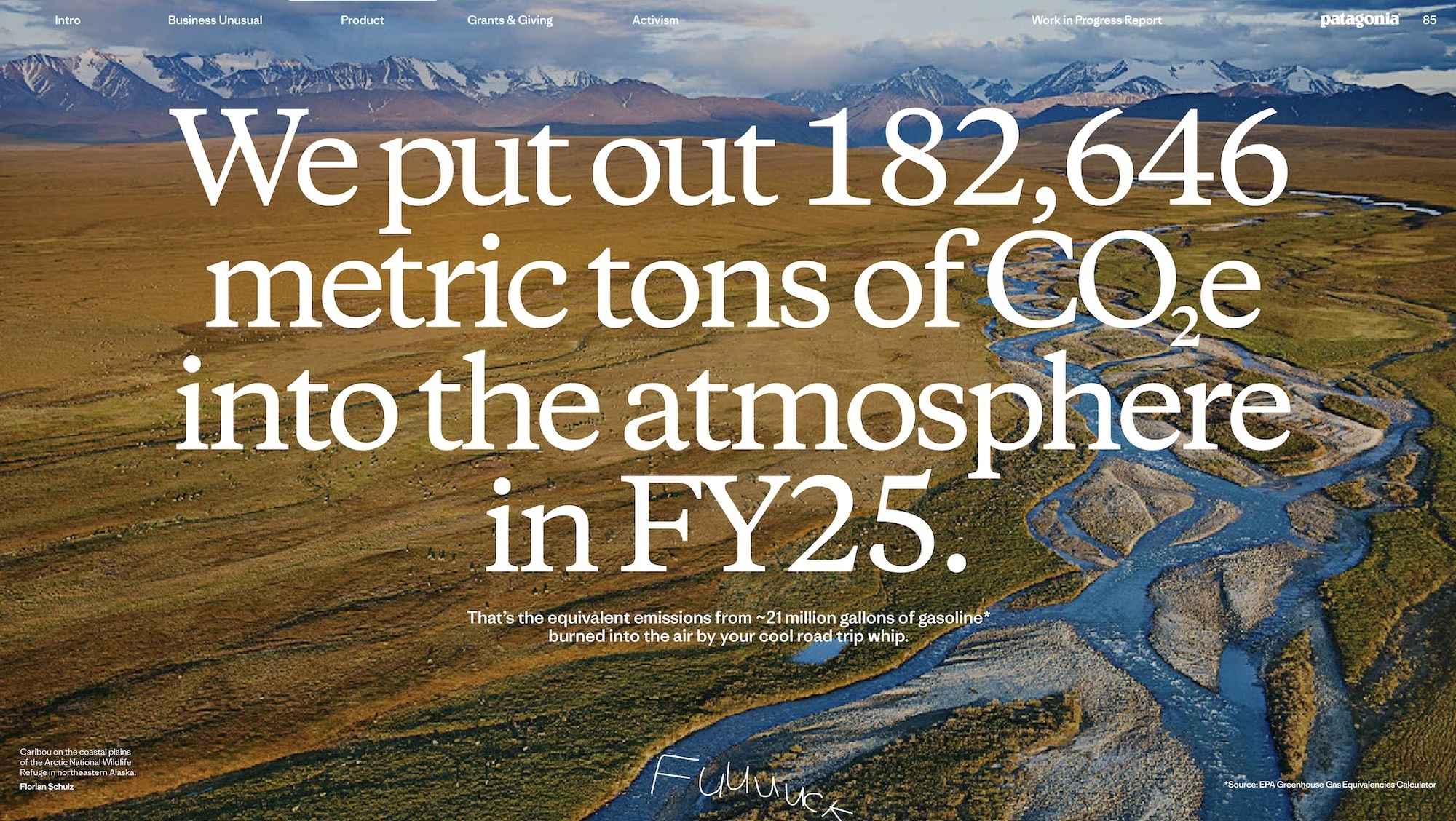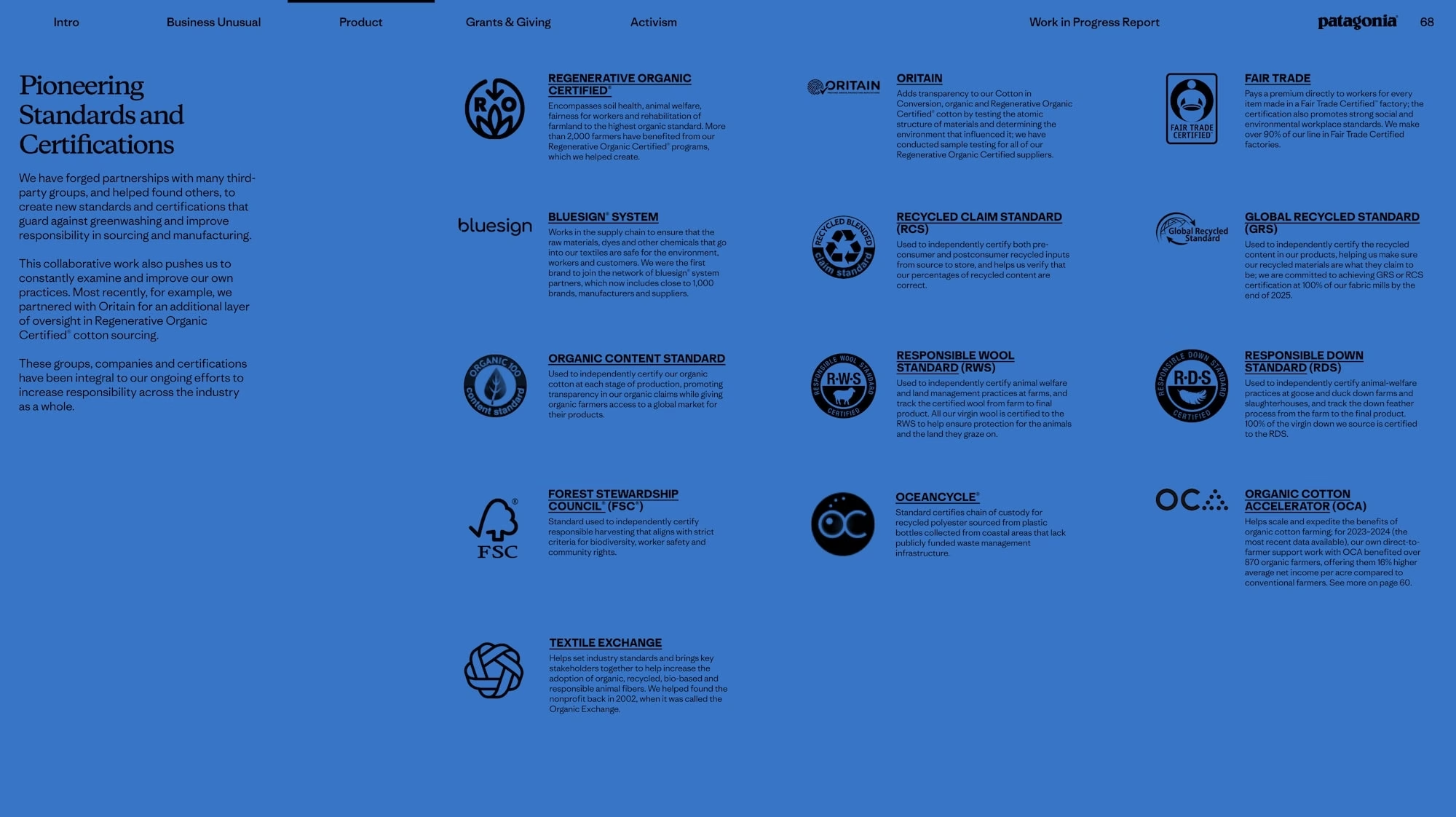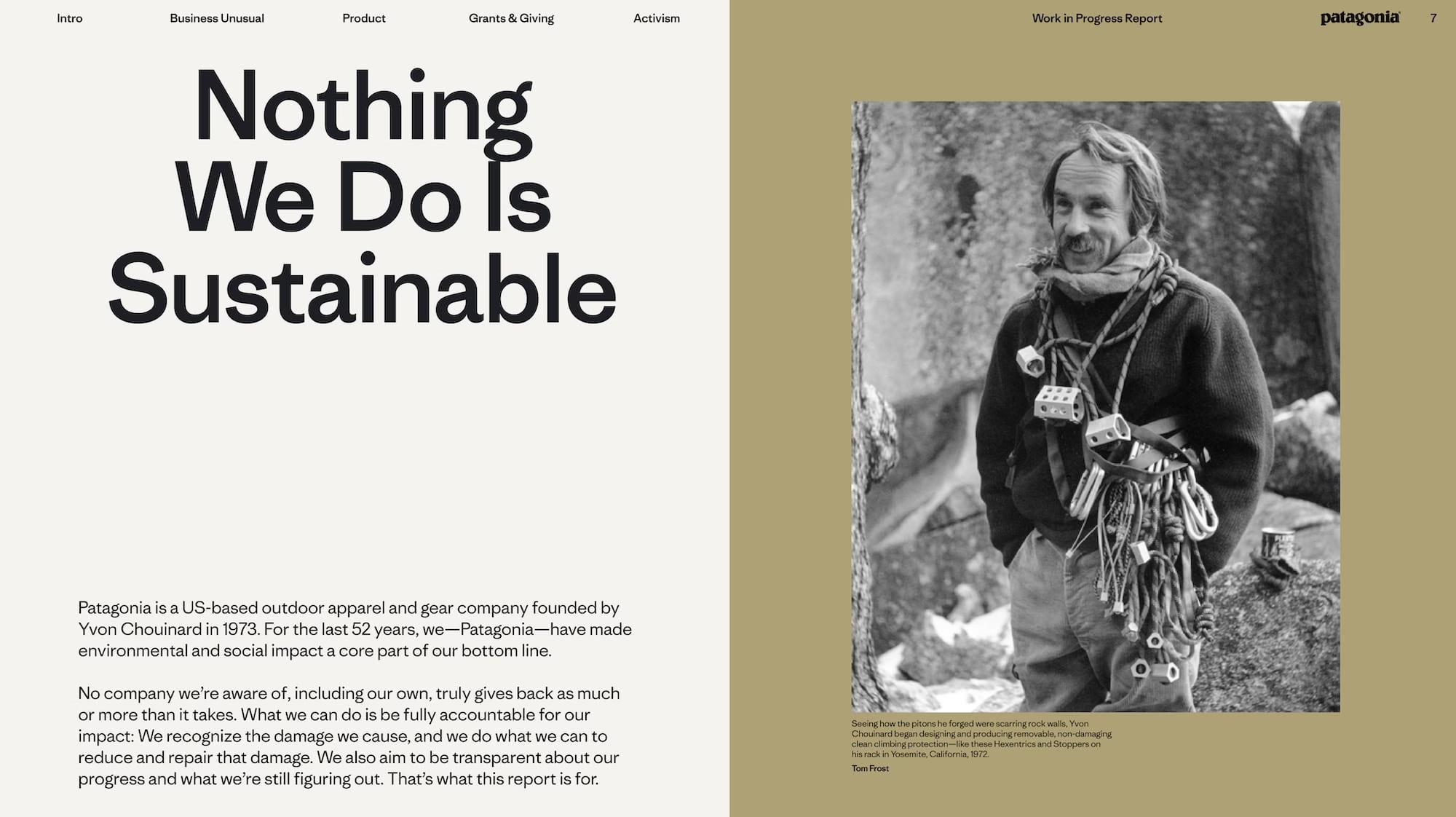Patagonia’s latest (and first) sustainability report makes for a fascinating read.
It helps us answer a question we’ve been curious about for a while: is all the reverence towards Patagonia merited? Is the worship deserved?
Could it even be, I mean we’re sorry to say this and it’s just a thought we had for a minute and we do definitely doubt it, but could it be that… Patagonia is, is gulp… g, g, g, greenwashing?
Well, now we’ve got some sauce from the report, let’s look at the case for and against.
The case to say Patagonia is certainly not greenwashing:
- Shareholder Earth: the company’s unique Holdfast Collective receives 98% of profits not reinvested into the business to put towards planet-defending work. Since it was founded in August 2022, Holdfast Collective has received $180 million from Patagonia. Not only that, 1% of Patagonia’s revenue is donated to 1% For The Planet, amounting to $14.7 million in FY25.
- Exceptional quality: Patagonia views quality as an environmental asset. They design products to last for generations, including repairs, using metrics like the (proprietary) Ironclad Quality Index.
- Circularity: Patagonia’s repair program is one of the industry’s best, fixing 174,799 products across the globe in FY25. Non-recyclable items are also being stored until a scalable solution is found, complementing the easy wins with a commitment to the long term.
- Workers: 95% of Patagonia’s factories are Fair Trade, all of them pay at least minimum wage, and more than a third pay a living wage.
- Transparency: if greenwashing is about lying or hiding then how can a brand that’s so honest in its reporting, and scrutinizing its supply chain so keenly, ever be greenwashing?
- Certifications: these help prove sustainability – at least the best certifications do – and Patagonia is backed by a bunch of the finest insignias on the market – from B Corp to GRS to Regenerative Organic. Here’s the full lineup:
The case to claim Patagonia is, perhaps, greenwashing:
- GHG emissions are increasing: Despite the 2040 net-zero goal, which is less ambitious than other major companies aiming at earlier dates, Patagonia’s overall Greenhouse Gas (GHG) emissions actually increased by 2% in FY25 compared to FY24. Compared with the baseline year of FY 2017, they’ve increased by around 25%. The company attributes this to a shift towards more carbon-intensive items like packs and duffels, meaning product strategy is disconnected from emissions reduction.

- 20% virgin synthetics: the report states that 80% of synthetic materials are recycled, leaving a simple process of deduction to reveal that 20% of synthetics are virgin materials – made from fossil-fuels and oil. When the company sells so many items to reach $1.47 billion in revenue over the last fiscal year, that’s a big environmental dent.
- Many materials are still not “preferred”: In Patagonia’s own terms, the goal to reach 100% ‘preferred’ materials (fibers or raw materials with reduced impacts compared to conventional equivalents) was missed by a long shot. The report states 84% of fabrics and trims (by purchased weight) are ‘preferred’, meaning a substantial 16% of the raw materials making up Patagonia’s products are still conventional equivalents with high environmental and social impacts. For example, spandex – made from fossil fuels – which is almost entirely still virgin at 96.6% used.
- Massive circularity shortfall: The goal to have 50% of recycled synthetics made from “secondary waste” (e.g., textile waste or ocean-bound nets) by 2025 was a spectacular wipeout, achieving only 6%. This highlights the perhaps-insurmountable challenge in scaling up true textile-to-textile or other “end-of-life” recycling technologies and moving past the most common (and less impactful) waste streams. Patagonia still makes the majority of its synthetic fabrics from recycled plastic bottles, which is not a truly eco-friendly process because these fabrics still leak microplastics and close a recycling loop that could otherwise remain open. Elsewhere, The report indicates that only 1% of products made are returned for recycling, and out of that small amount, only 20% can actually be processed. The end recycling rate slumps to 0.2%.
- What does the Earth get back? That striking 2022 move to guarantee “Earth is our only shareholder” grabbed headlines and went viral on social media but getting to the heart of this unique trust-structure’s impact, isn’t straightforward. Within the report, Patagonia’s founder notes that despite the ownership change unlocking a way to distribute more money for environmental causes, “it has never felt more difficult,” and the company explicitly states that its biggest negative environmental and social impacts are still concentrated upstream in its supply chain, where clothing is manufactured and over 90% of emissions are generated. Details on the trust’s exact activity over the past year are minimal – despite extensive transparency elsewhere.
- Sustainability is about people as well as planet and away from the report investigations have uncovered that Patagonia outsources its clothing manufacture to the same factories as those used by fast fashion houses like Primark with no clear difference to workers’ conditions. This scandal is alluded to on the company’s Good on You page where the company scores a lukewarm ‘It’s a Start’ relating to People. These issues arise because Patagonia outsources manufacturing to distant low-wage countries where conditions are tricky to control. The bulk of factories (44) are in Vietnam, Sri Lanka, Bangladesh and Indonesia. Patagonia is characteristically open about this approach on its website: “We design, test, market and sell Patagonia gear. These are our areas of strength. We pay other companies that have the technical expertise and equipment to produce the fabrics and do the actual cutting and sewing. This arrangement poses special challenges for us because we feel responsible for any work.”. It’s not a passage that reassures, though, is it?
The verdict: guilty or not guilty?
Look, we’re not blasé enough to call-out Patagonia for greenwashing. It would be unfair (and hubristic) to declare that a brand so intent on becoming the best version of itself is guilty of deception. We don’t even need to do that, Patagonia is so radically honest it would admit that it’s not even sustainable. It says exactly that at the beginning of the brand’s 2025 report: ‘Nothing we do is sustainable’.
Therein, however, lies a paradox. There’s an enormous gap between Patagonia’s perceived, incredible, sustainability and its real shortfall of sustainability. This gap is somehow widened by its self-effacement, which boosts perception. A bit like the famous ‘Don’t buy this jacket’ campaign that sent sales of jackets skyrocketing.
But radical honesty is just that: honesty. It doesn’t make you the thing you aspire to become after admitting your flaws.
Nevertheless, the more Patagonia says it’s not sustainable the more it makes people swoon. This is a brand that communicates skilfully and is not scared to make big gestures; perhaps a little too aware of the reverse psychology, to build a grand perception. That, however, is not greenwashing and is rather top-tier communications.
So what is Patagonia? For that, you need to look beyond the brand perception and at the actual details. After perusing the latest report, we’ll frankly say that the environmental reverence towards Patagonia is way out of proportion.
Just like the report says, Patagonia is not sustainable.
No! don’t start swooning at the swashbuckling transparency! It really isn’t. It’s striving and it’s dreaming but people confuse that dream with reality.
Instead, Patagonia should be seen plainly but fairly. On one hand, an enterprise that makes nearly $1.5billion in yearly revenue from clothes that are still largely made with synthetic textiles, whose GHG emissions appear to be increasing. Yikes! But on the other hand it’s a brand that is striving, honestly, and making moves that are way better than other multinational fashion brands who are doing nothing and hiding their hot messes. Its willingness to aim at the sky is inspirational at a time when inspiration is needed. If Patagonia weren’t here, which other global fashion company would be leading the way through hostile terrain; finding the dead-ends that could lead to other brands getting there?
When everything’s on fire, though, we should remember that Patagonia is not a colossal amount more than the sum of its parts. There are some serious imperfections. The company’s impact can’t continue unmitigated while it continues to talk so valiantly about defending the planet. And all the reverence distracts from other important brands out there who’re less pollutive than Patagonia and deserve exposure.
Let’s end on an unequivocal footnote that answers the post headline. Patagonia is not greenwashing. How can it be when it’s not lying and is so committed to improving? But perhaps we are guilty of being a little too credulous and impressionable, around a cult of brand personality.
Looking ahead, if Patagonia’s FY 2026 report makes for similar reading, alongside unadulterated planet-saving posturing, then the accusations of greenwashing might start to become more substantive. No matter how radically transparent that report is.
You can read Patagonia’s Work in Progress report, here.




Leave a Reply